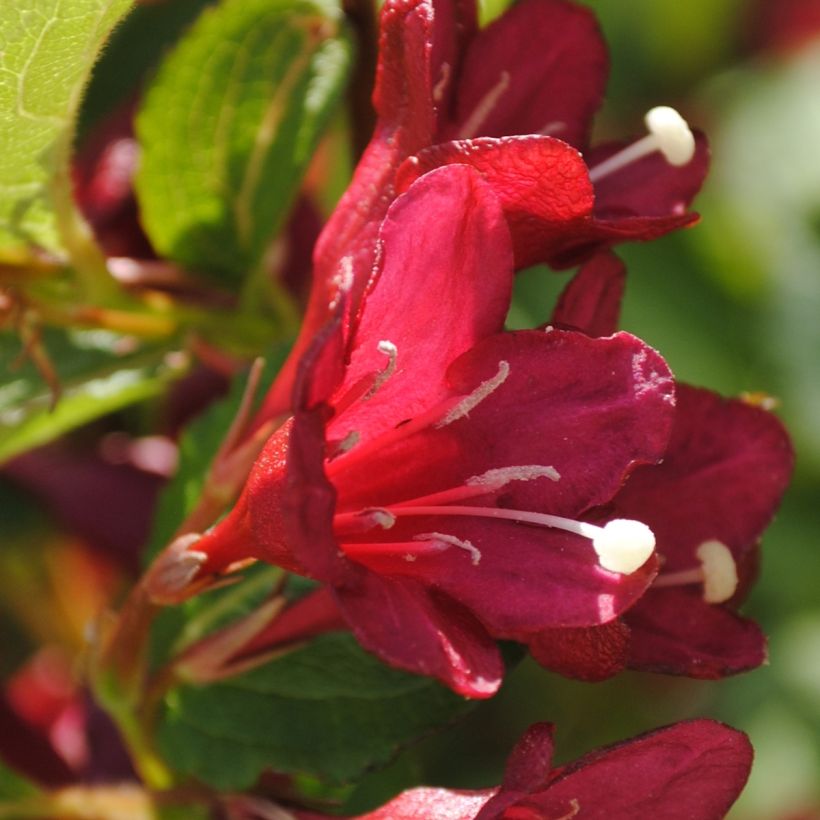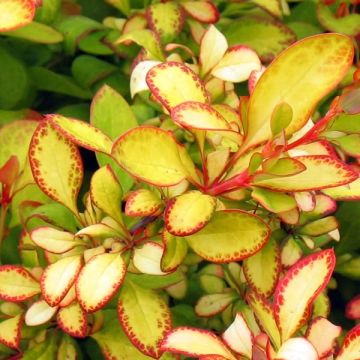

Weigela florida Cherry Lace
Weigela Cherry Lace
Weigela x florida Cherry Lace ®
Old-fashioned Weigela
Special offer!
Receive a €20 voucher for any order over €90 (excluding delivery costs, credit notes, and plastic-free options)!
1- Add your favorite plants to your cart.
2- Once you have reached €90, confirm your order (you can even choose the delivery date!).
3- As soon as your order is shipped, you will receive an email containing your voucher code, valid for 3 months (90 days).
Your voucher is unique and can only be used once, for any order with a minimum value of €20, excluding delivery costs.
Can be combined with other current offers, non-divisible and non-refundable.
Why not try an alternative variety in stock?
View all →This plant carries a 24 months recovery warranty
More information
We guarantee the quality of our plants for a full growing cycle, and will replace at our expense any plant that fails to recover under normal climatic and planting conditions.
Would this plant suit my garden?
Set up your Plantfit profile →
Description
Weigela florida Cherry Lace is a charming dwarf version of the 'Red Prince' variety from which it inherited its fantastic intense red flowering. Stockier than its predecessor, this shrub transforms at the end of spring into a veritable ball of cherry-red, lightly scented flowers, which fade elegantly. The radiant tone of this flowering is well highlighted by a thick, embossed foliage of a beautiful vibrant green. Whether in the ground or in a pretty pot, it is sure to be the centre of attention!
Native to northern China, Japan, and Korea, Weigela florida is a deciduous shrub belonging to the Caprifoliaceae family. This calcicolous (preferring calcareous soils) shrub has a fibrous and spreading root system, which perfectly supports transplantation. The 'Cherry Lace' cultivar is a very recent selection that has a rounded and bushy habit, with fairly flexible stems. It forms a ramified bush that will ultimately not exceed 80 cm (32 in) in all directions. Its funnel-shaped flowers, quite large compared to the type species, measuring 4 to 5 cm (2 in) long, are a very bright carmine-red, slightly lighter in the centre, enhanced by a white style that protrudes from the corolla. They are carried in corymbs, at the ends of the previous year's branches, and flower abundantly from May to June, and then more sporadically in summer. These flowers are also highly attractive to bees and provide nectar. Its deciduous foliage is composed of dark green, sessile leaves, meaning they have no petioles and are directly attached to the branches, pubescent on the underside, and oval in shape. The lamina, dentate at the edges, of a light green colour and with a particularly embossed texture, turns yellow in autumn before falling.
Hardy down to -20 °C (-4 °F), Weigela 'Cherry Lace' will thrive in many regions in sunny or semi-shaded locations and ordinary soil that remains moist but not too heavy. This small-sized variety that forms a ball of flowers brings a lot of brightness to the garden, as well as to the terrace. In a flower bed, for example, combine it with some Physocarpus, pheasant trees (Leycesteria formosa), ornamental brambles, a small viburnum chosen for its autumn colours (Viburnum 'Bailey Compact'), or a Purple Nana Barberry. In the background, the very dark foliage of holly, mahonias, or yews will create a setting for its colourful flowers and provide winter decor.
Weigela Cherry Lace in pictures


Plant habit
Flowering
Foliage
Botanical data
Weigela
x florida
Cherry Lace ®
Caprifoliaceae
Old-fashioned Weigela
Cultivar or hybrid
Other Weigela
View all →Planting and care
Hardy down to -20 °C (-4 °F), Weigela florida Cherry Lace thrives in sunny or semi-shaded positions; sunny exposures promote flower production. Plant it in a well-drained but still moist soil, with a neutral to slightly alkaline pH, from October to March (excluding the frost period). To maintain a compact habit and encourage abundant flowering, shorten the branches that have produced spring flowers by 2/3, just after flowering. Weigela is an easy-to-grow shrub but it does not like drought or sea spray.
Planting period
Intended location
Care
Planting & care advice
This item has not been reviewed yet - be the first to leave a review about it.
Similar products
Haven't found what you were looking for?
Hardiness is the lowest winter temperature a plant can endure without suffering serious damage or even dying. However, hardiness is affected by location (a sheltered area, such as a patio), protection (winter cover) and soil type (hardiness is improved by well-drained soil).

Photo Sharing Terms & Conditions
In order to encourage gardeners to interact and share their experiences, Promesse de fleurs offers various media enabling content to be uploaded onto its Site - in particular via the ‘Photo sharing’ module.
The User agrees to refrain from:
- Posting any content that is illegal, prejudicial, insulting, racist, inciteful to hatred, revisionist, contrary to public decency, that infringes on privacy or on the privacy rights of third parties, in particular the publicity rights of persons and goods, intellectual property rights, or the right to privacy.
- Submitting content on behalf of a third party;
- Impersonate the identity of a third party and/or publish any personal information about a third party;
In general, the User undertakes to refrain from any unethical behaviour.
All Content (in particular text, comments, files, images, photos, videos, creative works, etc.), which may be subject to property or intellectual property rights, image or other private rights, shall remain the property of the User, subject to the limited rights granted by the terms of the licence granted by Promesse de fleurs as stated below. Users are at liberty to publish or not to publish such Content on the Site, notably via the ‘Photo Sharing’ facility, and accept that this Content shall be made public and freely accessible, notably on the Internet.
Users further acknowledge, undertake to have ,and guarantee that they hold all necessary rights and permissions to publish such material on the Site, in particular with regard to the legislation in force pertaining to any privacy, property, intellectual property, image, or contractual rights, or rights of any other nature. By publishing such Content on the Site, Users acknowledge accepting full liability as publishers of the Content within the meaning of the law, and grant Promesse de fleurs, free of charge, an inclusive, worldwide licence for the said Content for the entire duration of its publication, including all reproduction, representation, up/downloading, displaying, performing, transmission, and storage rights.
Users also grant permission for their name to be linked to the Content and accept that this link may not always be made available.
By engaging in posting material, Users consent to their Content becoming automatically accessible on the Internet, in particular on other sites and/or blogs and/or web pages of the Promesse de fleurs site, including in particular social pages and the Promesse de fleurs catalogue.
Users may secure the removal of entrusted content free of charge by issuing a simple request via our contact form.
The flowering period indicated on our website applies to countries and regions located in USDA zone 8 (France, the United Kingdom, Ireland, the Netherlands, etc.)
It will vary according to where you live:
- In zones 9 to 10 (Italy, Spain, Greece, etc.), flowering will occur about 2 to 4 weeks earlier.
- In zones 6 to 7 (Germany, Poland, Slovenia, and lower mountainous regions), flowering will be delayed by 2 to 3 weeks.
- In zone 5 (Central Europe, Scandinavia), blooming will be delayed by 3 to 5 weeks.
In temperate climates, pruning of spring-flowering shrubs (forsythia, spireas, etc.) should be done just after flowering.
Pruning of summer-flowering shrubs (Indian Lilac, Perovskia, etc.) can be done in winter or spring.
In cold regions as well as with frost-sensitive plants, avoid pruning too early when severe frosts may still occur.
The planting period indicated on our website applies to countries and regions located in USDA zone 8 (France, United Kingdom, Ireland, Netherlands).
It will vary according to where you live:
- In Mediterranean zones (Marseille, Madrid, Milan, etc.), autumn and winter are the best planting periods.
- In continental zones (Strasbourg, Munich, Vienna, etc.), delay planting by 2 to 3 weeks in spring and bring it forward by 2 to 4 weeks in autumn.
- In mountainous regions (the Alps, Pyrenees, Carpathians, etc.), it is best to plant in late spring (May-June) or late summer (August-September).
The harvesting period indicated on our website applies to countries and regions in USDA zone 8 (France, England, Ireland, the Netherlands).
In colder areas (Scandinavia, Poland, Austria...) fruit and vegetable harvests are likely to be delayed by 3-4 weeks.
In warmer areas (Italy, Spain, Greece, etc.), harvesting will probably take place earlier, depending on weather conditions.
The sowing periods indicated on our website apply to countries and regions within USDA Zone 8 (France, UK, Ireland, Netherlands).
In colder areas (Scandinavia, Poland, Austria...), delay any outdoor sowing by 3-4 weeks, or sow under glass.
In warmer climes (Italy, Spain, Greece, etc.), bring outdoor sowing forward by a few weeks.



































































